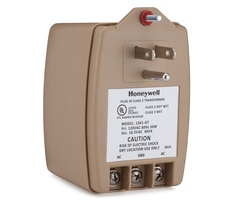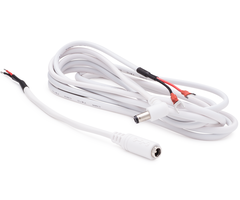How is AC Power Provided to a Security System?
AC power is provided to a security system through a plug-in transformer. You must run a wire between the transformer and the alarm panel to transmit power. This is a big step in setting up a system. An alarm system will also have a backup battery to provide power during electrical outages.

AC power represents the primary power source for an alarm system. The transformer is plugged into an AC outlet. The reason why it is called a "transformer" is because it transforms the high-voltage power into low-voltage power that is suitable for powering an alarm system. In some cases, this may involve switching the AC input power from the outlet to DC output power to the alarm panel. But it will almost always involve "stepping down" the power to something lower that won't overpower or damage the system. This is why you will often see it referred to as a step-down transformer.
All system transformers have wires that connect it to the alarm panel. This wire is traditionally detachable, and it can be removed or disconnected if needed. This design choice is intentional, as an installer can replace the wire if it becomes damaged. This way, they won't need to replace the entire transformer in a situation where only the wire is damaged. Another big reason for this design choice is because alarm systems have traditionally been installed by professionals, and a professional installer is expected to have cabling readily available in their work vehicle.
It is also important to consider that the length of wire between the transformer and the panel should only be long enough to comfortably make the connection, but no longer. A professional installer will be able to easily cut a specific length of cabling based on what is needed for the job. However, with the rise of DIY security systems, you may sometimes come across system transformers with "fixed-length", non-detachable wires that cannot be removed at the transformer. This eliminates the step of connecting the wires at the transformer, but it also means that the entire transformer may need to be replaced if the wire becomes damaged.
When setting up AC power, there are some things to keep in mind. First, there are usually wire run limits that must be adhered to. The length of wire between the transformer and the panel is limited based on the panel specifications. A small amount of current is lost as electricity travels down a cable. If the cable is too long, then not enough power will reach the panel, and it will not work properly. Using thicker wire will allow for a longer wire run. This is because thicker wire retains current more effectively than thinner wire. The most common cabling for alarm systems is between 18 gauge and 22 gauge. The lower the number of the gauge (AWG), the thicker the wire. Refer to the manual for your panel to determine the maximum wire run.
Second, it may be necessary to observe polarity. This basically means that the positive (+) and negative (-) wires should each be connected to the proper locations. This is only applicable on panels using DC power with a DC transformer. The DC transformer will have one terminal marked (+) for positive, and the other terminal is marked (-) for negative. Most installers will connect a red wire at positive (+) and a black wire at negative (-). Then, the positive (+) connection will be made at the designated panel terminal (often VDC, or +), and the negative (-) connection will also be made at its designated panel terminal (often GND, or -). Technically speaking, color doesn't matter, and either wire can be used at either terminal, as long as there is consistency from end to end. But using red for positive (+) and black for negative (-) can help you stay organized.
When using an AC to AC step-down transformer, the terminals will simply be marked with AC or GND. AC, or alternating current, does not observe polarity. In this case, either AC transformer terminal can connect at either of the panel's power terminals. The GND terminal shown in the image below does not require a connection, as long as the outlet being used is properly grounded. Remember to run the wires through the back plate or the back of the metal enclosure for the panel prior to completing the connections. This will allow you to properly close the panel once you are finished.

Most security systems have a transformer included. But cabling is not usually included, and the user must supply their own. There are exceptions to this rule, as some panels like the Qolsys IQ Panel 2 Plus will have a wire bundled with the system. But in most cases, you should expect to purchase your own. Traditional 18 AWG or 22 AWG wiring can be found at virtually any hardware store. This wire is not pre-prepared, and a user must use a wire stripper to expose copper at the ends so that the connections can be made. Stripping wire is not too difficult, but it may take some practice at first. We strongly advise using stranded wire as opposed to solid core wire, as stranded wire is easier to bend without breaking.
However, Honeywell also released a prepared cable called the Honeywell LT-Cable that eliminates this step. The cable is split into a long portion and a short portion that meet at a male-female barrel connection. One end of the long portion has spade connectors that are ideal for connecting at the transformer terminals. The other end leads to the male barrel connector. Some panels like the 2GIG GC3e have a female barrel port on the board so that you can simply plug in the connector. The LT-Cable is Center Positive when it is used in this manner. But most alarm panels will require you to complete the male-female connection and use the smaller portion of the LT-Cable to connect to the panel's power terminals. The smaller portion of the LT-Cable has the female barrel port on one end and prepared positive (red) and negative (black) wire ends that can be easily inserted into panel power terminals. If you need to remove power, you can simply unplug the barrel connection, rather than unplugging the entire transformer.

In addition to using AC or DC power from a transformer, a security system will almost always have a backup battery set up. This accessory is designed to keep a system running temporarily during AC loss situations. The rechargeable backup battery will draw a small amount of power from the AC connection so that it is ready to kick-in once AC power is lost. Keep in mind that a battery can only keep a system running temporarily. The actual length of time depends on the system and the battery. In most cases, the backup battery will keep the system running anywhere from four (4) hours to 24 hours. When you need to power down a system entirely for hardware changes, you must disconnect both battery and transformer power. When powering down, disconnect the battery first, followed by the transformer second. Then when powering back up, you should connect the transformer first and the battery second for a wired system, and the battery first and transformer second for a wireless system.
Did you find this answer useful?
We offer alarm monitoring as low as $10 / month
Click Here to Learn MoreRelated Products

Related Videos
Related Categories
- Answered

